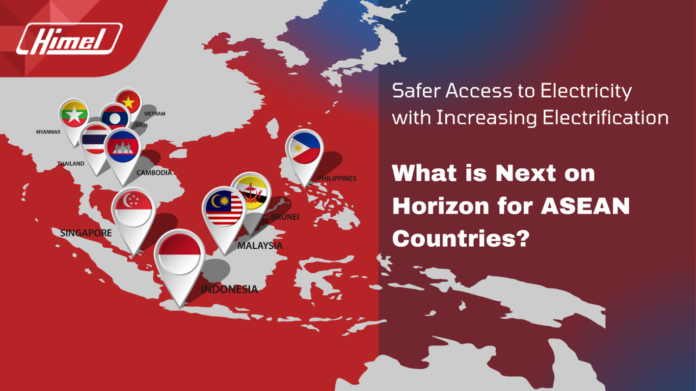__________________________________________________________________________________
Association of Southeast Asian Nations or ASEAN is a diverse group including Brunei,
Myanmar, Cambodia, Timor-Leste, Indonesia, Laos, Malaysia, the Philippines,
Singapore, Thailand and Vietnam. Several of these countries are fast-growing
economies with their immense potential heavily dependent on manufacturing and
trade. To keep growing as economic powerhouse, balance urbanization and
consumer growth in tandem, these countries require accelerated electrification and
modernization of existing electrical infrastructure.
_________________________________________________________________________________
As we stand on the precipice of a new decade, a fundamental question echoes across the vibrant tapestry of ASEAN nations: how can we ensure safer access to electricity for all? This seemingly simple question holds the key to unlocking not just illumination, but a cascade of positive transformations—from economic prosperity to educational equity, improved healthcare, and environmental sustainability.
While the region has witnessed remarkable progress in recent years, the statistics paint a sobering picture. According to the International Energy Agency, around 65 million people across the ten ASEAN countries still lack access to electricity, with rural areas disproportionately affected. This lack of basic infrastructure hinders education, livelihoods, and traps communities in a cycle of poverty.
Electricity is needed to power the most basic services in healthcare facilities, from ensuring clean water supply to keeping communication on, let alone lightning. It is also crucial for the medical equipment necessary to ensure immunization or safely manage childbirth and for undertaking most of the routine and emergency procedures. According to WHO reports, approximately 12% of healthcare facilities in South Asia lack access to electricity whatsoever. This is a stark reminder that the absence of electricity is not merely an inconvenience; it’s a matter of life and death.
One of the primary hurdles in addressing this issue is the outdated and inadequate infrastructure that plagues certain regions. The World Bank estimates that around 50% of the population in the ASEAN region relies on traditional and often hazardous cooking methods, highlighting the critical need for comprehensive electrification initiatives.
But amidst the challenges, glimmers of hope emerge. Governments are ramping up electrification initiatives, with a focus on renewable energy sources like solar and hydro. Vietnam, for instance, aims to achieve universal electricity access by 2025, while Indonesia is investing heavily in mini-grids and off-grid solutions to reach remote areas.
Technological advancements are also playing a vital role. Smart grids are being deployed to optimize energy distribution and minimize losses. Digital platforms are connecting consumers directly to energy providers, fostering transparency and affordability. And the rise of microfinance is enabling low-income communities to access solar panels and other clean energy solutions.
However, there’s still much work to be done. The infrastructure gap remains substantial, requiring an estimated investment of USD 210 billion by 2030. Policy frameworks must evolve to incentivize private sector involvement and foster innovation. Community engagement is crucial to ensure culturally sensitive solutions that address local needs and challenges.
Looking ahead, several key areas demand unwavering focus. At high level, prioritizing grid expansion and modernization, embracing renewables and empowering communities and human capital need to be executed. Simultaneously, to make this shift faster and cost-efficient, adoption of value engineered electrical products is imperative.
The concept of value engineering has gained significant importance in recent times, especially in emerging economies where cost-effective products without compromising on quality or durability are in high demand. Especially, recent pandemic and extreme climate situations have highlighted the need to focus not only on development but also on contingency and recovery in ASEAN countries. By providing necessary functions in product, application, and project through cost-efficient design, procurement, production, and supply, value engineering enables cost-inexpensive development and modernization. This approach allows reduction in costs while maintaining the quality and durability of electrical infrastructure. Himel, as a leader of value engineered electrical products has successfully implemented cost efficient electrical infrastructure in residential, commercial and industrial applications.
__________________________________________________________________________________
In context of development of resilient industrial and commercial ecosystem in ASEAN
countries, value-engineered electrical products can play a crucial role in how well and
how soon the electrical infrastructure can be developed, scaled up, or modernized.
__________________________________________________________________________________
As several ASEAN countries are dealing with a mammoth task of balancing modernization of electrical infrastructure and accelerated development of new electrical set-up; value engineered electrical products can facilitate making the costs of operations and technology more efficient.
Safer access to electricity for all is not just a humanitarian imperative; it’s a strategic investment in ASEAN’s future. It’s about unleashing the full potential of its people, driving economic growth, and securing a sustainable future for generations to come. And, the imperative for safer access to electricity in ASEAN countries demands a multi-faceted approach that goes beyond traditional infrastructure development. In the recent years, Himel has successfully initiated conversation on impact of employing value engineered electrical products in cost efficient, faster and safer infrastructure modernization.
By harnessing the power of innovative technologies, embracing value engineered electrical products, and efficient power source mix, the region can pave the way for an equitable and safer future. That said, governments, businesses, communities, and individuals need to join hands to illuminate the path towards a brighter future for all. This will not only foster collaboration, but drive the necessary transformations that will empower communities, spur economic growth, and propel ASEAN nations towards a brighter, electrified future.
About Himel
Himel is an award-winning global manufacturer and supplier of electric products for Low Voltage Power Distribution, Final Distribution, Power Management, Motor Control and Protection, Industrial Components, and Home Electric offers. With a footprint in 50+ countries—the brand is a leader in value-engineered electric products for residential, commercial, and industrial sectors, providing the best combination of affordable and reliable offers to meet the demand for access to safe electricity.
Article received on email.
Interested to gain more information about Himel? Then please read these links:
Implementing Fire Resistant Electrical Infrastructure for Residential Safety
Driving modernization of power infrastructure through value engineered electrical products
Maximizing Safety in Rapid Urbanization with Value Engineered Electrical Products






